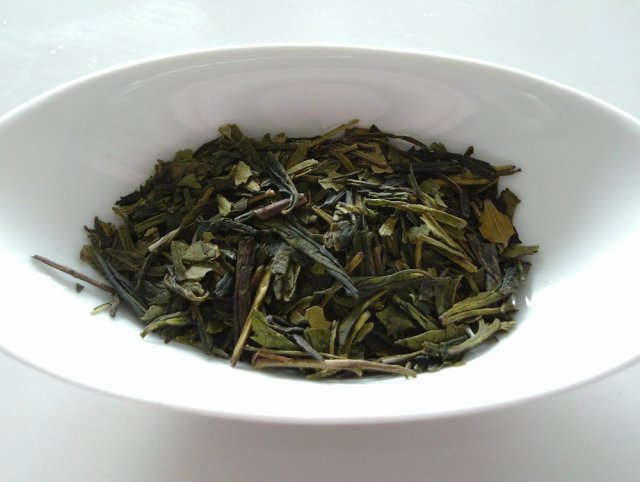
Longjing tea leaves
Longjing, which means Dragon Well, is a pan-fired green tea, which comes from from the area around Longjing Village, near Hangzhou City in Zhejiang Province, China.
The village itself is named after a well, the legendary home to “The Dragon That Rules The Seas“, which produces superb quality spring water even in times of drought.
The tea so impressed the Qianlong Emperor that he gave the tea the status of Gong Cha, or Imperial Tea, and reserved 18 tea bushes for his own, personal use. The bushes still exist to this day, and the tea they produce is more valuable than gold by weight.
Today Longjing tea appears on virtually every “Famous Teas of China” list, and high quality, authentic Longjing can command a very high price.
The unsteeped tea is characterised by its flattened, sword like leaves, as well as its wonderful aroma, which is often described as “chestnutty“, although personally I pick up a feeling of baked goods, almost biscuit-like.
I bought this particular Longjing here in town, at one of our local tea shops. I paid 69 Swedish Crowns for a 100g packet.
Unfortunately, neither the shop assistant or the company website could provide any further information as to the tea’s grade or geographical origin. Although the shop assistant warned that the tea was towards the “bottom of the barrel” so to speak, being near to the last of the batch in the large caddy in which it was stored, the leaf didn’t look excessively broken, and still had a good aroma, so I decided to purchase some nevertheless.
I decided to treat this as a “special” tea, rather than an all-day, everyday drinker, reserving it for those quiet moments in the mid-afternoon, when I have time to sit down, and steep teas Asian style.

Longjing tea in the cup
I like to drink this tea for the sake of drinking it alone, so tend to shun eating any snacks with it. It makes for an excellent “stare out to sea and contemplate the state of the world” kind of a tea.
I’ve steeped this particular Longjing in both a gaiwan as well as my Samadoyo E-01 teapot, and it performed very well, good for 6 or 7 infusions before it started to tail off in the taste and aroma stakes.
The first infusion was incredibly aromatic and slightly astringent. It wasn’t until the second and third infusion that the tea’s sweetness began to shine through.

Longjing tea leaves after 6 infusions
Definitely a tea all serious tea lovers should be familiar with.

I have to confess to not being aware of this tea. It looks like a tea to enjoy. Thanks Chloe.
http://pinkiebag.com/
LikeLike
Thanks for reading.
It’s definitely a tea worth splashing out on if you can track it down. You won’t be disappointed..!
LikeLiked by 1 person
It definitely sounds like one to track down in Britain. I love hearing about the history of the plants too, a great read!
LikeLike
Thanks, glad you liked it.
I know what you mean – I also love reading about the myths, legends, and histories associated with the various tea types. They’re almost as enjoyable as the tea itself…!
LikeLiked by 1 person
Brilliant. This is how tea should be cherished. I have found it at http://www.tea-and-coffee.com which is where I get my teas from. It goes under the name Dragon Well tea. After reading this it is definitely on my next order.
LikeLike
Thanks. Glad you liked it.
Treat your Dragon Well with a little respect and you’ll be in for a memorable tea experience…!
LikeLike
Pingback: Maojian – The Darling Buds of Spring | Diary of a Northern Teaist
Pingback: West Lake Longjing | Diary of a Northern Teaist